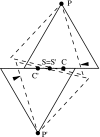Packing, tiling, and covering with tetrahedra
- PMID: 16818891
- PMCID: PMC1502280
- DOI: 10.1073/pnas.0601389103
Packing, tiling, and covering with tetrahedra
Abstract
It is well known that three-dimensional Euclidean space cannot be tiled by regular tetrahedra. But how well can we do? In this work, we give several constructions that may answer the various senses of this question. In so doing, we provide some solutions to packing, tiling, and covering problems of tetrahedra. Our results suggest that the regular tetrahedron may not be able to pack as densely as the sphere, which would contradict a conjecture of Ulam. The regular tetrahedron might even be the convex body having the smallest possible packing density.
Conflict of interest statement
Conflict of interest statement: No conflicts declared.
Figures








Similar articles
-
New family of tilings of three-dimensional Euclidean space by tetrahedra and octahedra.Proc Natl Acad Sci U S A. 2011 Jul 5;108(27):11009-12. doi: 10.1073/pnas.1105594108. Epub 2011 Jun 20. Proc Natl Acad Sci U S A. 2011. PMID: 21690370 Free PMC article.
-
Disordered, quasicrystalline and crystalline phases of densely packed tetrahedra.Nature. 2009 Dec 10;462(7274):773-7. doi: 10.1038/nature08641. Nature. 2009. PMID: 20010683
-
Exact constructions of a family of dense periodic packings of tetrahedra.Phys Rev E Stat Nonlin Soft Matter Phys. 2010 Apr;81(4 Pt 1):041310. doi: 10.1103/PhysRevE.81.041310. Epub 2010 Apr 30. Phys Rev E Stat Nonlin Soft Matter Phys. 2010. PMID: 20481720
-
[Parallel structures in multidimensional networks].Biofizika. 2006 Nov-Dec;51(6):1106-33. Biofizika. 2006. PMID: 17175922 Review. Russian.
-
Statistics for ChIP-chip and DNase hypersensitivity experiments on NimbleGen arrays.Methods Enzymol. 2006;411:270-82. doi: 10.1016/S0076-6879(06)11014-9. Methods Enzymol. 2006. PMID: 16939795 Review.
Cited by
-
Tetrahedron clusters serving as a platform for foam-like structure design.Nanoscale Adv. 2024 Jan 15;6(4):1183-1192. doi: 10.1039/d3na00470h. eCollection 2024 Feb 13. Nanoscale Adv. 2024. PMID: 38356615 Free PMC article.
-
Octo-diamond crystal of nanoscale tetrahedra with interchanging chiral motifs.Nat Mater. 2025 May;24(5):785-793. doi: 10.1038/s41563-025-02185-y. Epub 2025 Mar 24. Nat Mater. 2025. PMID: 40128626 Free PMC article.
-
Mathematical physics: A tight squeeze.Nature. 2009 Aug 13;460(7257):801-2. doi: 10.1038/460801a. Nature. 2009. PMID: 19675632 No abstract available.
-
Phoamtonic designs yield sizeable 3D photonic band gaps.Proc Natl Acad Sci U S A. 2019 Nov 19;116(47):23480-23486. doi: 10.1073/pnas.1912730116. Epub 2019 Nov 6. Proc Natl Acad Sci U S A. 2019. PMID: 31694882 Free PMC article.
-
Assembly of planar chiral superlattices from achiral building blocks.Nat Commun. 2022 Jul 21;13(1):4207. doi: 10.1038/s41467-022-31868-2. Nat Commun. 2022. PMID: 35864092 Free PMC article.
References
-
- Torquato S. Random Heterogeneous Materials: Microstructure and Macroscopic Properties. New York: Springer; 2002.
-
- Conway J. H., Sloane N. J. A. Sphere Packings, Lattices and Groups. New York: Springer; 1998.
-
- Hales T. C. Ann. Math. 2005;162:1065–1185.
-
- Bezdek A., Kuperberg W. Appl. Geom. Discrete Math. 1991;4:71–80.
-
- Wills J. M. Mathematika. 1991;38:318–320. (1991)
LinkOut - more resources
Full Text Sources
Other Literature Sources

